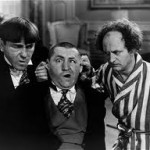As it turns out, not one of the gentleman in our photo is a Federal Air Marshal. In fact, trying to pick out the air marshal on transcontinental and overseas flights has become a sort of game for travelers, something to do while the seatbelt lamp is lit. It is usually assumed that the muscular guy in the aisle seat in First Class is one of the onboard marshals. But it is more likely he’s a programmer heading for a tech conference. The reality is that there are far fewer Air Marshals then the public imagines and the odds are extremely good that your flight is operating without any security with the possible exception of a pilot who carries a piece.
President Kennedy initiated the program in 1963 and deployed marshals on high risk flights. When the United States was attacked on 9/11 there were only thirty-three FAM’s on active duty. In 2005, Homeland Security Chief Michael Chertoff placed the air marshals under the command of the Department of Homeland Security.
In 2008, CNN did an exhaustive investigation and published a report indicating that the network’s sources state that “Air Marshals are Missing from Almost All Flights.” The TSA responded vigorously saying it would not give out specific numbers but CNN’s assertion that only 280 of the 28,000 daily flights in the USA had onboard Marshals. That is stated in the plural but, in fact, no one really knows if marshals work alone or with partners. The TSA would not, of course, say how many flights have on-board protection but they said the number was in the “four digits” as opposed to the 280 number.
CNN conducted exhaustive interviews with pilots who said they flew long-haul flights for several years without encountering any marshals on their planes. We do know that, given the required number of flying hours and time away from home, there have been shortages of trained personnel. Training is said to be quite rigorous but no nearly as rigorous as serious covert military training. The first phase of training begins in Artesia, New Mexico where recruits undergo a six week Law Enforcement coure. This is followed by rather secretive final training at a facility called the William J. Hughes Technical Center in New Jersey.
FAM’s work out of 21 field offices and are on current one hour notice to deploy to high-risk airports for flight assignment. As to the matter of whether or not Marshals are armed – a quick yes. They carry a Sig Sauer P229 pistol. It is interesting to note that it was, pre 2006, relatively easy to spot Federal Air Marshals based on the required clothing they wore and their need to pre-board before handicapped passengers and children. They also stayed at a designated FAM hotel on arrival. But that has changed and air mnarshals can now wear whatever works and they use the same security entrances as most passengers.
The exact number of current Federal Air Marshals is of course a well kept secret. But the CNN Report did point out that several FAM’s they spoke to off the record were concerned about the lack of coverage on flights in and out of Washington D.C> and New York. It also appears that in TSA lingo, a flight that is considered to be security “covered” may, in fact, not have any air marshals on board. Covered, in TSA parlance, could mean that there is a certified armed law enforcement person aboard the flight. But rather than a FAM sitting with passengers, “covered” often means that a pilot is armed.
